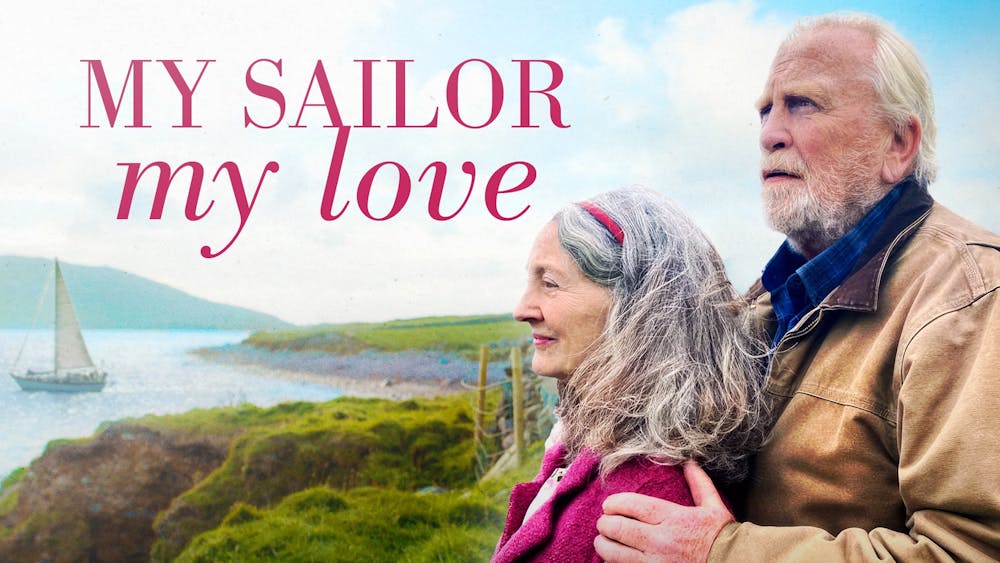It’s as much a love story as it is a story about falling out of love.
Though Klaus Härö’s 2022 film “My Sailor, My Love” capitalizes on melodrama to create an emotionally charged narrative, the film shot on an island off the Irish coast lacks a specificity that ultimately renders it vague and a bit cliched.
Howard (James Cosmo), an older man and retired sailor, lives alone in a grand house overlooking the Irish coast — he spends his days mostly alone, occasionally weaving and frequently sitting in his dark living room in front of the fireplace. His house is disheveled: Framed photographs cluster the walls, dishes pile up in the sink and dust accumulates on tabletops. It’s clear that Howard is unfit to adequately care for himself.
Howard’s daughter, Grace (Catherine Walker), visits her father often to help with his household obligations — but it's help that is certainly not welcomed. Grace’s efforts are met with biting hostility from Howard, who resents her for making the effort to care for him. It’s an agonizing relationship that deeply affects both parties. Their relationship is made worse by the negligence of Howard’s sons, who make little effort to care for their aging father. At best, it’s an uncomfortable dynamic to watch on screen.
Eventually, Grace places an advertisement for a housekeeper on the bulletin board of a local pub — an extra set of hands to help care for her father would allow her to put greater effort into her failing marriage. It’s Annie (Bríd Brennan) who answers Grace’s call.
Like the lifting of fog on an Irish morning, the film’s earliest moments are characterized by a haziness that clings to each shot. Particularly inside Howard’s house, the hazy shots prevent the audience from getting a clear sense of the interior’s makeup: Shadows cling to corners and faces appear almost as silhouettes. The filming presents a facade that initially prevents viewers from seeing the characters clearly.
Hazy shots are contrasted by wide-sweeping panoramas of the Irish coast. These shots come to appear regularly throughout the film, yet they add little to the plot. Apart from gesturing towards Howard’s past life as a sailor, these shots generally appear arbitrary and break with the film’s focus on the mundane.
Eventually, Annie arrives for her first day of work at Howard’s home with a bright enthusiasm. She goes about the house merrily, completing chores with lightness. She makes dinner for Howard at the end of her shift — as the bitter man he is, he takes one bite and refuses to eat the rest. He orders her to leave.
Howard’s rudeness is rectified by a simple apology the next day when he goes into town with a bushel of yellow flowers for Annie. She accepts his apology all too quickly, agreeing to return to his home for work in the coming days — an exchange that lacks believability. It’s on these uneasy grounds that the plot begins in earnest and their romantic relationship begins to emerge.
Just as Howard begins to love anew, Grace’s marriage is jeopardized. She refuses to talk with her husband who, by all accounts, expresses concern for her mental wellbeing. Grace is an obstacle to herself, the care she directs toward her father impeding her from connecting with her husband. Her past trauma — having to care for her late mother before she committed suicide — proves another plot point that restricts Grace from empathizing with her husband. All the while, Howard falls in love with Annie. She gives him a new lease on life. Before long, Grace begins to express contempt for her father’s new relationship.
The juxtaposition between the two relationships exemplifies the overwraught nature of the film. Most scenes lack subtlety. Even in the peculiar circumstances the film presents, most of the characters are presented as both vague and general. Cliched moments are all too common, which further contributes to this lack of subtlety. When picking apples, for example, Howard and Annie awkwardly graze their hands along the same piece of fruit that’s been plucked from a tree — they exchange a bashful glance, meant to hint at their blossoming love. Except, it's not a hint, but an explicit tell.
A question hangs over the film: What does Annie see in Howard? The general lack of knowledge about each protagonist makes it hard to gauge the answer. Sure, their love is special because they’re both old — but what is there beyond that?
A positive attribute of the film lies in its motif of photographs. Howard is connected to his past life — his deceased wife, absent sons and Grace. The photographs — alongside the trinkets and artifacts that intersperse the home — serve as a record of a crumbling family that is put in contact with a new, emerging one. It’s interesting to watch Annie and Howard’s relationship develop in the presence of these memories. It’s perhaps even more interesting to witness the conflict that defines the second half of the film in their presence.
While “My Sailor, My Love” is entertaining throughout, the film’s lack of subtlety renders it less impactful. It’s a decent watch for fans of melodrama and Irish cinema, but offers little for everyone else.





